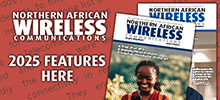06 October 2023

Daniel Batty, space and spectrum policy analyst, Access Partnership
With the 8th sub-Saharan Spectrum Management Conference recently ending, and the 4th African Preparatory Meeting now underway, discussions around bridging the digital divide and the role of different communications typologies in providing solutions to the continent are rife. The long saga, which involves international mobile telecommunications (IMT), fixed wireless access (FWA), and satellite communications still goes on, especially as consensus is still being sought on key Agenda Items, such as 1.2 and 1.3.
Setting the scene on the African continent
Over the preceding decade, Africa has seen significant developments in the availability of communications infrastructure and the deployment of next generation mobile communications infrastructure, including 4G and 5G. All the while, satellite networks continue to provide a suite of services, including broadcasting, communications (both direct and backhaul), and internet. Additionally, advances in satellite services, such as direct-to-device (D2D), seem poised to revolutionise rural and last mile connectivity.
While connectivity solutions continue to evolve on the continent, so does the nature of the digital divide. The coverage gap, referring the percentage sub-Saharan Africans who do not have access to network services, has continued to shrink, now down to 19%. However, it should be noted that much of this coverage is comprised of older generation IMT, such as 2G and 3G services, and is focused on urban population centres – highlighting that although the coverage gap in Africa has decreased, there remains a gap between urban and rural areas of the continent.
As the coverage gap has shrunk, the usage gap has grown, increasing to 49% across sub-Saharan Africa. This refers to the number of users actively utilising the networks available to them. Several causes are responsible for the usage gap, with infrastructure constraints as well as the affordability of communications devices and connectivity services, such as data plans, serving as key obstacles.
What’s more, when defining connectivity, it is vital to outline its meaning. Closing the coverage gap entirely does not mean sub-Saharan Africa will suddenly benefit from the promises of expanding connectivity. Meaningful connectivity means connection to the internet that is “safe, satisfying, enriching and productive at an affordable cost” (WTDC, 2022), in alignment with the short and mid-term goals of the continent.
Satellite in Africa
Satellite connectivity is a vital component for sub-Saharan Africa connectivity, both present and future. This has been facilitated through enabling satellite broadcasting, communications networks, and more recently, internet and D2D. These are, however, only the communications aspects of satellite services. Satellites over Africa continue to provide invaluable weather monitoring, Earth observation, tracking, and Internet of Things (IoT) services. These provide commercial and institutional advantages to the continent.
Satellite connectivity has seen a marked decrease in cost, following advancements in antennas, satellite services, and capabilities. The existence of geostationary orbit (GSO) and non-geostationary orbit (NGSO) cohabiting satellite systems allows for the expansion of services across their entire orbit path around the globe. The expansion of low Earth orbit (LEO) has translated into reduced user service costs – LEO constellations are significantly lower than their large GSO cousins, which makes them cheaper to build, deploy, and operate, while also decreasing their ping and increasing connection speed. Today, LEO constellations can provide stable internet at about 150Mbps speeds.
Outside the scope of connectivity, Africa has revealed its interest in revitalising national space programmes, amid hopes of attracting investment from foreign launcher companies for whom sub-Saharan Africa’s large equatorial region could be utilised to maximise launch efficiency.
To date, 53 satellites have been launched by African states, with Kenya being the most recent launchers. These satellites are mostly Earth observation satellites, which provide valuable data on marine ecosystems, floods, drought and other natural disasters, and agricultural data such as crop and soil erosion monitoring. These services directly contribute to the socio-economic development of the regions they serve.
The challenge at WRC-23
This WRC cycle is poised to be one of the most critical for sub-Saharan Africa – the active development of an African position over the past three preparatory meetings has proven contentious, with member states raising their voices for various solutions to the connectivity problem.
There are several key Agenda Items of note to the satellite industry in Africa, with the two most contentious being 1.2, which aims to allocate more spectrum in the upper 6GHz band to IMT, and Agenda Item 1.3, which seeks a primary allocation for mobile services in the C-Band midband (3600-3800MHz). While there are plenty of other Agenda Items of interest to satellite communications, special focus is being given to these two.
Agenda Item 1.2 presents a challenge to several other services in the C-band, including WiFi and satellite. While 3GPP has completed its standardisation for 5G in the upper 6GHz band, there are other problems which must be addressed. These include harmonisation and interference, and not least of all, acknowledging that at present, large portions of IMT spectrum are not actively being used.
Agenda Item 1.3, which seeks to allocate more midband spectrum to mobile services, has two possible outcomes which African states are deciding upon. These include whether to allocate the entire portion and allow member states to individually opt out of assigning 3800MHz to mobile, or whether to allocate 3600-3700MHz and allow member states to individually opt in to assigning 3800MHz.
These two agenda items will shape how satellite services are provided in Africa in the future and must be mindful of the services satellites provide – both within and out of the communications sector. They must also be cognisant of planning for the future of more satellite launches, African space missions, and satellite services.






